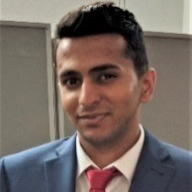
Ranvir Singh Bhogal
Work place: Department of Computer Science, Loughborough University, UK
E-mail: r.s.bhogal@gmail.com
Website:
Research Interests: Artificial Intelligence, Neural Networks, Computer Networks
Biography
Ranvir Singh Bhogal received a BSc in Computer Science with the diploma in Professional Studies from Loughborough University. He has strong research interests in image processing, encryption, robotics and AI. He undertook various algorithm and software development projects in artificial neural networks, mobile robot navigation and communication. As a Software Engineer and Test Analyst in the construction and payments industry he has worked on a large scale of web-based service platforms and financial systems.
Author Articles
Medical Image Encryption using Chaotic Map Improved Advanced Encryption Standard
By Ranvir Singh Bhogal Baihua Li Alastair Gale Yan Chen
DOI: https://doi.org/10.5815/ijitcs.2018.08.01, Pub. Date: 8 Aug. 2018
Under the Digital Image and Communication in Medicine (DICOM) standard, the Advanced Encryption Standard (AES) is used to encrypt medical image pixel data. This highly sensitive data needs to be transmitted securely over networks to prevent data modification. Therefore, there is ongoing research into how well encryption algorithms perform on medical images and whether they can be improved. In this paper, we have developed an algorithm using a chaotic map combined with AES and tested it against AES in its standard form. This comparison allowed us to analyse how the chaotic map affected the encryption quality. The developed algorithm, CAT-AES, iterates through Arnold’s cat map before encryption a certain number of times whereas, the standard AES encryption does not. Both algorithms were tested on two sets of 16-bit DICOM images: 20 brain MRI and 26 breast cancer MRI scans, using correlation coefficient and histogram uniformity for evaluation. The results showed improvements in the encryption quality. When encrypting the images with CAT-AES, the histograms were more uniform, and the absolute correlation coefficient was closer to zero for the majority of images tested on.
[...] Read more.Other Articles
Subscribe to receive issue release notifications and newsletters from MECS Press journals